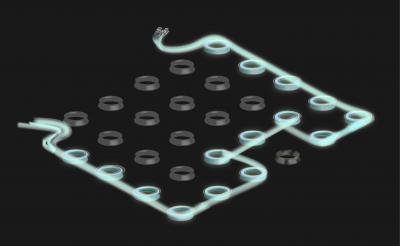It is easier to transmit information-rich photons several thousand miles via fiber-optic cable than for a few nanometers inside a computer chip.
The Joint Quantum Institute (JQI), operated by the University of Maryland and the National Institute of Standards and Technology (NIST), in collaboration with Harvard University is conducting a research to use photons as information carriers within a computer chip. The study paves the way to develop ultra efficient information processors for desktops and understand the phenomenon called the quantum Hall effect where electrons can interact with themselves as they move in a magnetic field.
 Proposed JQI fault-tolerant photon delay device for a future photon-based microchip
Proposed JQI fault-tolerant photon delay device for a future photon-based microchip
Jacob Taylor, who serves as theoretical physicist at JQI and NIST, stated that problems arise when photons are used in microcircuits due to mild defects in the materials chips are produced from. These defects are especially challenging when they crop up in photon delay devices, as they slow down the photons.
Delay devices are normally fabricated from a single array of small resonators. Thus, a defect amidst them can mess up the data in the photon stream. However, the researchers observed that utilizing multiple arrays of resonators would construct alternate pathways in the delay devices, enabling the photons to detect their path around defects easily.
Delay devices are critical components of computer circuits. Hence, the alternate-pathway method may tackle hurdles hindering the photon-based chip development. According to Mohammad Hafezi, JQI’s research associate, the possibility of studying the quantum Hall effect using the same technology is also a major scientific breakthrough.